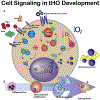Heterotopic ossification and the elucidation of pathologic differentiation
- PMID: 28987285
- PMCID: PMC6585944
- DOI: 10.1016/j.bone.2017.09.019
Heterotopic ossification and the elucidation of pathologic differentiation
Abstract
Tissue regeneration following acute or persistent inflammation can manifest a spectrum of phenotypes ranging from the adaptive to the pathologic. Heterotopic Ossification (HO), the endochondral formation of bone within soft-tissue structures following severe injury serves as a prominent example of pathologic differentiation; and remains a persistent clinical issue incurring significant patient morbidity and expense to adequately diagnose and treat. The pathogenesis of HO provides an intriguing opportunity to better characterize the cellular and cell-signaling contributors to aberrant differentiation. Indeed, recent work has continued to resolve the unique cellular lineages, and causative pathways responsible for ectopic bone development yielding promising avenues for the development of novel therapeutic strategies shown to be successful in analogous animal models of HO development. This review details advances in the understanding of HO in the context of inciting inflammation, and explains how these advances inform the current standards of diagnosis and treatment.
Keywords: Bone morphogenetic protein receptors; Ectopic bone; Inflammation.
Copyright © 2017 Elsevier Inc. All rights reserved.
Figures


References
-
- Kaplan FS, Shore EM, Progressive osseous heteroplasia, J. Bone Miner. Res 15(11) (November 2000) 2084–2094. - PubMed
-
- Shore EM, Xu M, Feldman GJ, et al., A recurrent mutation in the BMP type I receptor ACVR1 causes inherited and sporadic fibrodysplasia ossificans progressiva, Nat. Genet 38 (5) (May 2006) 525–527. - PubMed
Publication types
MeSH terms
Grants and funding
LinkOut - more resources
Full Text Sources
Other Literature Sources
Medical

